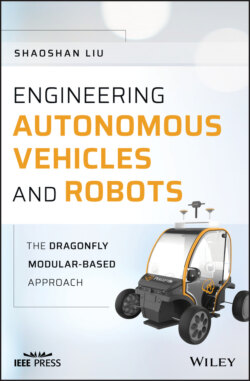Читать книгу Engineering Autonomous Vehicles and Robots - Shaoshan Liu - Страница 37
2.4.3 Data Transmission and Network Management
ОглавлениеSimilar to other field bus systems, CANopen distinguishes two basic data transmission mechanisms: the access to entries of the object dictionary through “Service Data Objects” (SDOs) The exchange of process data through “Process Data Objects” (PDOs). PDOs are transmitted according to the producer–consumer principle in the form of broadcast messages and can be event-triggered, cyclically transmitted, or requested by a node without any additional protocol overhead. A PDO can be used for the transmission of a maximum of 8 data bytes.
In connection with a synchronization message (“Synchronous PDO”), the transmission as well as the acceptance of PDOs can be synchronized across the network. The mapping of application objects into the data field of a PDO is configurable through a data structure called “PDO Mapping” which is stored in the object dictionary. This allows the dynamic configuration of a device according to the specific requirements of an application.
The transmission of data via an SDO channel is performed in the form of a client–server relationship between two nodes. The addressing of an object dictionary entry is accomplished by providing the index and the subindex of the entry. Transmitted messages can be of very large length. The transmission of SDO messages of more than 8 bytes involves an additional fragmentation protocol overhead. Standardized event-triggered “Emergency Messages” of high priority are reserved to report device malfunctions. A common system time can be provided through a system time message.
NMT functions such as controlling and monitoring the communication status of the nodes are accomplished by a NMT facility. This is organized according to a logical master–slave relationship. Two mechanisms for node monitoring (“node-guarding” and “heartbeat-messaging”) are provided alternatively. The assignment of CAN message identifiers to PDOs and SDOs is possible by direct modifications of identifiers in the data structure of the object dictionary or, for simple system structures, through the use of predefined identifiers. Besides device profiles, a variety of application specific profiles developed by several specific interest groups are currently available and a wide variety of manufacturers support CANopen by means of CANopen-based devices, tools for configuration, and testing as well as certified CANopen protocol stacks.
